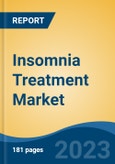Speak directly to the analyst to clarify any post sales queries you may have.
10% Free customizationThis report comes with 10% free customization, enabling you to add data that meets your specific business needs.
One of the fundamental aspects of global insomnia treatment involves education and awareness campaigns to inform the public and healthcare providers about the prevalence and consequences of insomnia. This includes disseminating information about sleep hygiene practices, lifestyle modifications, and the importance of seeking professional help when necessary. Such efforts aim to reduce the stigma associated with sleep disorders and promote early intervention.
Key Market Drivers
Rising Prevalence of Insomnia
The rising prevalence of insomnia has emerged as a significant catalyst for the growth of the global insomnia treatment industry. Insomnia, characterized by persistent difficulty falling asleep or staying asleep, has become increasingly common in today's fast-paced, digitally connected world. Stress, anxiety, lifestyle changes, and the prevalence of electronic devices that disrupt sleep patterns have all contributed to this escalating problem. According to data from the World Sleep Society, approximately 30% of adults experience short-term insomnia, while 10% suffer from chronic insomnia. This surge in insomnia cases has translated into a surge in demand for effective treatments.As more individuals experience sleep disturbances and their associated negative consequences on physical and mental health, they are turning to healthcare providers for solutions. This growing awareness of the detrimental impact of untreated insomnia has led to more individuals seeking medical attention and diagnosis, thereby driving up the number of reported cases and fueling the demand for insomnia treatment options. Also, the National Library of Medicine reports that approximately 30% of adults experience insomnia symptoms, emphasizing the urgent need for effective treatments. This growing demand has driven pharmaceutical companies and healthcare providers to develop innovative therapies and expand their offerings, fueling significant market growth.
Key Market Challenges
Underdiagnosis and Misdiagnosis
Insomnia, a prevalent sleep disorder characterized by difficulty falling or staying asleep, continues to plague millions across the globe. While the demand for effective treatments rises, the global insomnia treatment industry grapples with a significant barrier: underdiagnosis and misdiagnosis. This dual challenge not only hampers the growth of the treatment sector but also exacerbates the plight of those enduring sleepless nights.For many, insomnia is dismissed as a mere consequence of a busy lifestyle, stress, or a transient phase. The normalization of sleepless nights has led many sufferers to overlook their symptoms, often hesitating to seek professional guidance. This pervasive attitude contributes to the vast underdiagnosis of insomnia, with numerous cases going unreported. As a result, a significant portion of the population remains deprived of appropriate treatment, enduring the physical, psychological, and socio-economic repercussions of untreated insomnia.
Key Market Trends
Rise in Telemedicine and Remote Healthcare
The rise in telemedicine and remote healthcare has emerged as a pivotal trend boosting the global insomnia treatment industry. Insomnia, a widespread sleep disorder affecting individuals worldwide, has historically presented challenges in terms of access to specialized care. However, the advent of telemedicine and remote healthcare solutions has ushered in a new era of accessibility and convenience for those in need of insomnia treatment.The COVID-19 pandemic played a significant role in accelerating the adoption of telemedicine across various medical specialties, including sleep medicine. As social distancing measures and lockdowns disrupted traditional healthcare delivery, patients turned to virtual consultations with sleep specialists and therapists for their insomnia-related concerns. This shift in healthcare delivery eliminated geographical barriers, enabling individuals from diverse locations to access expert guidance and treatment options for their sleep disorders.
Key Market Players
- Merck & Co
- Pfizer Inc.
- Abbott Laboratories
- Genentech Inc.
- LGM Pharma
- Sigma Aldrich Corp.
- Sanofi S.A
- Takeda Pharmaceuticals Co. Ltd.
- Eisai Ltd.
- Idorsia Pharmaceuticals Apotex Corp
Report Scope:
In this report, the Global Insomnia Treatment Market has been segmented into the following categories, in addition to the industry trends which have also been detailed below:Insomnia Treatment Market, By Type:
- Acute Insomnia Chronic Insomnia
- Onset Insomnia
- Maintenance Insomnia
- Behavioral Insomnia of Childhood
Insomnia Treatment Market, By Drugs:
- Eszopiclone
- Ramelteon
- Zaleplon
- Zolpidem
- Estazolam
- Others
Insomnia Treatment Market, By Distribution Channel:
- Hospital Pharmacies
- Retail Pharmacies
- Online Pharmacies
Insomnia Treatment Market, By Region:
- North America
- United States
- Canada
- Mexico
- Europe
- France
- United Kingdom
- Italy
- Germany
- Spain
- Asia-Pacific
- China
- India
- Japan
- Australia
- South Korea
- South America
- Brazil
- Argentina
- Colombia
- Middle East & Africa
- South Africa
- Saudi Arabia
- UAE
- Egypt
Competitive Landscape
Company Profiles: Detailed analysis of the major companies present in the Global Insomnia Treatment Market.Available Customizations:
With the given market data, the publisher offers customizations according to a company's specific needs. The following customization options are available for the report.Company Information
- Detailed analysis and profiling of additional market players (up to five).
This product will be delivered within 1-3 business days.
Table of Contents
Companies Mentioned
- Merck & Co
- Pfizer Inc.
- Abbott Laboratories
- Genentech Inc.
- LGM Pharma
- Sigma Aldrich Corp.
- Sanofi S.A
- Takeda Pharmaceuticals Co. Ltd.
- Eisai Ltd.
- Idorsia Pharmaceuticals Apotex Corp
Table Information
| Report Attribute | Details |
|---|---|
| No. of Pages | 185 |
| Published | March 2025 |
| Forecast Period | 2024 - 2030 |
| Estimated Market Value ( USD | $ 3.12 Billion |
| Forecasted Market Value ( USD | $ 4.26 Billion |
| Compound Annual Growth Rate | 5.4% |
| Regions Covered | Global |
| No. of Companies Mentioned | 10 |









